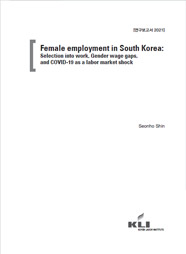한국노동연구원 'Publications in English'에 대한 설명 입니다.
Publications in English
Publications in English

Female Employment in South Korea: Selection into Work, Gender Wage Gaps, and COVID-19 as a Labor Market Shock
- Author Seonho Shin
- Publication Date 2021.12.30
- Length 190
- ISBN 979-11-260-0543-5
Content
Chapter 1 Introduction
Chapter 2 Has the gap
really narrowed? Selection-correction and ‘true’ gender wage gaps in South
Korea: A semi-parametric approach
Chapter 3 COVID-19’s
unequal impacts on gender employment gaps in South Korea: Has she earned a
bachelor’s degree?
Chapter 4 Female
migrants’ double burden - The labor market impact of COVID-19 on migrants in
South Korea: A Diff.-in-Diff. approach exploiting local outbreaks
Chapter 5 Non-technical summaries & Policy notes
Summary
When this research was initiated in January 2021, South Korea, the 10 th biggest economy in the world, was at the intersection of three colossal crises—the population decline, labor shortages, and the COVID-19 pandemic. The situation was, and still is, unprecedentedly severe in that those disasters are closely intertwined and that one can make the other even worse. The number of births in the nation plummeted to a record low in the year 2021; the population, according to national census statistics for 2020, has fallen for the first time in its history; to make matters worse, the pandemic abruptly curtailed the number of migrant workers to come to South Korea, while seriously hampering the employment of existing migrants at the same time. Among those three obstacles, the most fundamental one is the demographic realities of low birth rates. After years of failed attempts to encourage population growth, the South Korean government now states that it will focus on learning how to live with population decline—rather than halting it (Lee, 2021). The government plans to implement a two-track strategy to deal with a shrinking and aging population: (i) encourage births, per se, and (ii) attract more minority groups, such as females, seniors, and migrants, to remain in the labor force. This is the starting point of the current research, which sheds light on two of those three minority groups: namely, females and (female) migrants in the context of the South Korean labor market. In the present research, they are scientifically investigated through the lens of three empirical topics. In consideration of the paucity in research, Chapter 2 questions whether gender wage gaps in South Korea, which has long held the largest gender pay gap among OECD countries, have narrowed by allowing for non-random, systematic selection of individuals into employment. On the other hand, in view of the importance of COVID-related economic research, Chapters 3 and 4 investigate labor market impacts stemming from the pandemic on females and women migrants, respectively.
 Source Indication + Commercial Use Prohibition + Change Prohibition
Source Indication + Commercial Use Prohibition + Change Prohibition